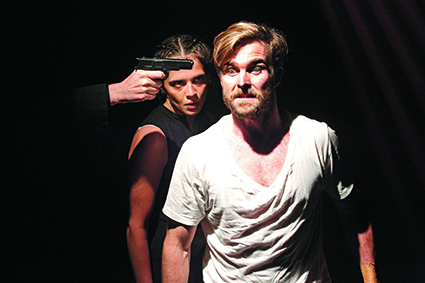Performance & the restoration of the real
Andrew Fuhrmann: Richard Murphet, Quick Death/Slow Love

Slow Love, Richard Murphet, La Mama Theatre
photo Jeff Busby
Slow Love, Richard Murphet, La Mama Theatre
Let’s start with a remark from the philosopher Gilles Deleuze: “The modern fact is that we no longer believe in this world. We do not even believe in the events which happen to us, love, death, as if they only half concerned us. It is not we who make cinema; it is the world which looks to us like a bad film.”
Is this true? Does the modern world seem to us like a poorly scripted romantic comedy or a banal disaster flick, some vast congeries of clichés, a place where nothing new ever happens? And can theatre restore our faith in the real? Can it cut through the formulaic conventions and re-connect us with the world as it is, and with the elemental influences of love and death?
These questions—it seems to me—are crucial to Richard Murphet’s Quick Death and Slow Love, two short plays first produced at La Mama in the early 1980s and revived here for the Melbourne Fringe Festival.
The room is empty except for a single chair and an old mattress. A young man in blue slacks and a white T-shirt enters. He seems uneasy, unsure what to make of this small, dimly lit space. From offstage we hear the sound of typing and the cry of a baby. The man sits in the chair, as if to settle his nerves. Then he stands up and turns to the audience—and all at once his uneasiness transforms into a look of horrified recognition. We hear a gunshot. The man falls and the lights go out.
When they come up again, he is back on his feet. We hear another gunshot. Once more he collapses, once more the lights go out. And that’s the machinic process of Quick Death, a lightning pageant in which the man, Raymond, is gunned down some 30-odd times in less than an hour.
“Men kill other men,” says a woman from offstage, as if issuing a sombre mandate. “Mostly men kill other men.” And this is what happens. Other voices are heard and other figures are seen: images and snatches of dialogue from an ensemble of crime films and noir thrillers accumulate. But in this dark, dissociated world the only through-line is fear, and the danger of violent death.
Quick Death first appeared in 1981 as part of Jean-Pierre Mignon’s premiere Anthill season and featured on a double bill with Artaud’s To Have Done with the Judgment of God. During the late 1970s, Murphet was a core member of the Australian Performing Group offshoot Nightshift, and Quick Death can be seen as a continuation of the confrontational energy of that inspired, self-dramatising avant-garde collective.
In 1983 he developed Slow Love, a sort of companion piece. Like the first, this second play develops image by image, segmented by blackouts, parodying filmic tropes. As the title indicates, however, the rhythm is more measured, with none of the earlier work’s convulsive violence. Instead it has a sort of quiet intensity—mesmeric, not disruptive. Across more than 80 brief scenes we watch four figures, two male and two female, fall in and out of love, arranging and rearranging themselves according to a logic of exhaustive variation.
Directed for the first time by Murphet himself, and revised in collaboration with the present cast, the two plays are performed here without interval. It is the physicality of the production which most impresses. Murphet’s method is to body forth the clichés of love and death—and, in the process, to exaggerate them—reducing spectacular distance and asserting a sense of communal space.
The actors deserve credit—and so do the sound and light operators—for throwing themselves so wholeheartedly into this quick-change tumult. Even in Slow Love, we still sense the bodies hurtling around backstage between the many scenes. Always we are conscious of the physical effort needed to transform the scudding shades of the cinema into theatrical substance. Kevin Kiernan-Molloy is particularly memorable as the eternally doomed central figure of Quick Death, staggering and swaggering and forever going down.
Live performance, the movement of bodies in an empty space, exhausts the glamour of cinema, pushes it until the spell breaks; and in the aftermath we sense the possibility of something new, something beyond the serried repetitions of the silver screen.
But I also wonder. The regime of images that these two plays engage recalls an earlier, perhaps simpler time, say of Humphrey Bogart and Lauren Bacall, of The Big Sleep and To Have and Have Not. Today the romance machine produces gonzo pornography. And the death machine gives us a vast and always open library of digital snuff videos. It is no longer just Deleuze’s “bad film” which stands between us and the world. Now there is also the bad meme. Clichés proliferate at 100 megabits per second: can even the most passionately experimental live theatre keep up?
Or does it come back to faith—faith that there is always some new creative possibility hidden within the real? In these two plays, both more than 30 years old, you do sense a kind of reverent power, a manifest conviction, even if, in performance, it is apprehended only for a moment, in the darkness and the charged silence that precedes the applause.
[To read more about Quick Death, Slow Love and other works by Richard Murphet, go to Denise Varney’s Radical Visions 1968-2008, Rodopi, Amsterdam & New York, 2011. Eds]La Mama Theatre, Quick Death/Slow Love, writer, director Richard Murphet, performers Kevin Kiernan-Molloy, Emma Tufrey Smith, James Cook, Naomi Rukavina, sound design Daniel Czech, set design Jacob Battista, lighting Steve Hendy, costumes Rebecca Dunn; La Mama, Melbourne, 30 Sept-11 Oct
RealTime issue #130 Dec-Jan 2015 pg. 44






